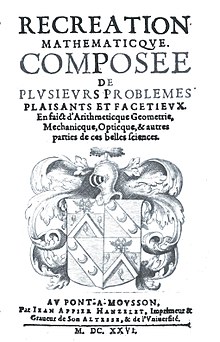Jean Leurechon
Jean Leurechon (* 1591 in Bar-le-Duc ; † January 17, 1670 in Pont-à-Mousson ) was a French mathematician and Jesuit .
Leucheron was the son of a doctor and entered the Belgian Jesuit college of Tournai as a novice at the age of 18 . Although his parents were against it and a judgment by the Parlement of Paris obtained him to be published, Leucheron continued his studies in Nancy and in Pont-à-Mousson. From 1614 to 1627 he taught as a mathematics professor in Pont-à-Mousson. In 1626 he entered the Jesuit order. He is the author of a book on entertainment mathematics ( Recreation mathematicque ) that appeared in 1624 and is one of the first such books to have the term entertainment mathematics in the title. In 1627 he went to Reims and was probably also in Paris and Rouen to supervise the printing of his book. In 1628/29 he was back in Pont-à-Mousson. From 1629 to 1634 he was rector of the Jesuit college of Bar-le-Duc, 1634/35 in Metz and from 1635 to 1637 in Pont-à-Mousson as theology professor at the Jesuit college. From 1637 to 1647 he was professor of theology in Mons and from 1647 to 1655 in the Jesuit college Missio Castrensis in Brussels . From 1658 he was back in Pont-à-Mousson.
The sources of his book include Giambattista della Porta , Jean Errard , Salomon de Caus , his teacher Jean Chastelier (* 1552 or 1554; † 1629 or 1630) and above all Claude Bachet ( Problemes plaisans et delectables , Lyon 1612). In the editions published in Paris there are in the edition of 1626 (third edition) notes by the mathematician Denis Henrion (DHPEM) and in the fourth edition of 1627 by Claude Mydorge (DALG), who introduced additional problems. In addition to mathematical tasks, he also deals with machines and equipment, for example the ear trumpet is dealt with for the first time, astronomy, navigation, architecture (perspective), optics, music and acoustics, hydraulics and mechanics. The book influenced similar books by Marin Mersenne and Daniel Schwenter (expanded by Georg Philipp Harsdörffer ) and appeared in numerous editions - supplemented and abbreviated differently - up to the entertainment mathematics books by Jacques Ozan in 1750. A Latin edition by his students appeared in 1629. Europe-wide He became known with the English edition 1633 (publisher William Oughtred ) and the Dutch (place of publication Arnheim, published by Wynant van Westen) and German edition 1636 (Munich). In the foreign editions, the name Hendrick Van Etten, one of his students and nephew of his publisher, appeared on the cover, which led to confusion about the author (in literature Hendrick Van Etten was also used as a pseudonym of Leucheron). In an edition of 1628 a book about fireworks from Thybourel first published in 1620 is included.
He also published a book on the comet of that year in 1618 and a collection of his mathematical works in 1622.
Fonts
- Discours de la comète apparue aux mois de novembre et décembre de l'année 1618
- Selectae propositiones in tota sparsim mathematica pulcherrimae, Pont-à-Mousson, 1622, 2nd edition 1629
- Recreation mathematicque; composee de plusieurs problemes plaisants et facetieux; en faict d'arithmeticque geometrie, mechanicque, opticque, et autres parties de ces belles sciences, Pont-à-Mousson: Jean Appier Hanzelet, 1624
Web links
Individual evidence
- ↑ As early as 1631, 30 exercises were included in the book Newe Recreation by Nicolas Hunt, published in London
- ↑ One can also see Schwenter's book in Nuremberg as a greatly expanded and revised version.
| personal data | |
|---|---|
| SURNAME | Leurechon, Jean |
| BRIEF DESCRIPTION | French Jesuit and mathematician |
| DATE OF BIRTH | 1591 |
| PLACE OF BIRTH | Bar-le-Duc |
| DATE OF DEATH | January 17, 1670 |
| Place of death | Pont-à-Mousson |
